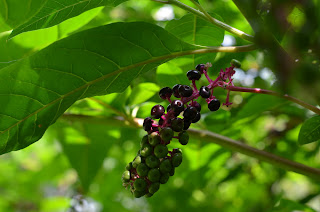It's follow up time! In June, I wrote about young pokeweed that was just beginning to thrive here. Now, in August, it's much easier to observe the mature fruit of this troublesome plant. If you're just learning to spot these nasty invaders, here are some current photographs to help you hone in your identification eyes.
Here, you can see a 7-foot tall pokeweed (Phytolacca americana) covered in berries. Note the purple hue in the stem.
 |
| Large pokeweed |
 |
| Mature pokeweed berries are deep purple in color. |
Once you learn to identify pokeweed, you'll begin to notice this native vegetation popping up everywhere. If you have interest, Iowa State University provides a brief but thorough overview of this pesky plant.
 |
| This mature pokeweed stands 7 feet tall. |
The mature pokeweed plant is so lush and tantalizing, it seems a bit of a shame to have to evict such an aesthetic wonder. But this dangerous beauty can pose a serious threat to humans if mishandled, so sadly, on our property, it just has to go.
All of these photographs were taken on local hikes, so to gain confidence in positively identifying this plant, look closely. Spend a moment to let the image sink in and make an effort to identify pokeweed on your own next adventure in the woods. It's exciting to learn about the plants that are native to our region and wise to have information about the effects they might have on pets and humans.
If you'd like to review some of the original, young pokeweed shots I posted in June, you can view them here. As always, if you have any questions, comments or interesting new links, please feel free to post.
Get out there and enjoy the rest of the season safely!
XOXO From My Hearth to Yours

3 comments:
Man, oh man, we played with a lot of pokeweed. We used to make dyes and paint things; I'm very surprised we never ingested any...
I read that the Native Americans used to use the berries to make paint and dye! AND...some people tried to use the berries to color wine- until those who drank it got incredibly ill from the toxins. Um, THAT was a bad idea. Duh. :) Learning curve, I guess.
I am sorry that someone has misinformed so many people about one of the most wonderful plants that provide healing to so many people FOR FREE. The poke berry plant is an awesome plant for medicinal purposes, also many of us have eaten poke salad greens for generations. I had a stiff knee that I could barely walk on for about a year. I tried a Native American remedy of swallowing one berry up to ten berries in increment of ten days then back to zero in ten. It cured the knee for a couple years. Then I repeated the process again, same results. My grandfather performed the first full-hip transplant in NC several decades ago, not a family of idiots. Go to a herbalist website about poke berry use. The FREE healing these plants provide is what causes the extreme toxins if you can imagine that!!!! And yes, like any other medicine, don't eat the whole medicine cabinet-full at one time. Same with any non-free drug.
Post a Comment